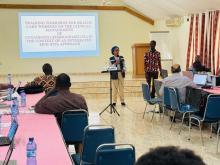From Diagnosis to Action – WHO’s Efforts to Strengthen Ghana’s Health Workforce Against Cutaneous Leishmaniasis
Neglected Tropical Diseases (NTDs) continue to burden some of the most vulnerable populations globally, and Ghana is no exception. Among these diseases, Cutaneous Leishmaniasis (CL) remains a pressing public health concern, particularly in the Volta and Oti Regions. A significant number of cases were diagnosed in three districts in 2003 and the disease is still endemic in several municipalities today, underscoring the urgent need for a strengthened health response. Recognizing this, the World Health Organization (WHO), in collaboration with Ghana Health Service (GHS), Noguchi Memorial Institute of Medical Research (NMIMR) and Kumasi Center for Collaborative research (KCCR), organized a training workshop in June 2024 to build the capacity of frontline healthcare workers in diagnosing, managing, and reporting CL and other skin related NTDs.
Addressing a Critical Gap
For years, one of the major challenges in controlling CL in Ghana has been the limited expertise at the primary healthcare level. Many frontline health workers lacked the necessary skills and resources to effectively detect and manage CL cases, leading to delayed diagnoses and inadequate patient care. This gap was further underscored by a 2021 ulcer sampling survey, which confirmed the endemicity of Cutaneous Leishmaniasis (CL). The study revealed that 87% of biopsies tested positive for CL, with approximately 70% of these cases involving multiple infections, including Haemophilus ducreyi and yaws. These findings emphasize the need for an integrated approach to diagnosing and managing skin-related NTDs.
A Comprehensive Training Approach
To address this challenge, WHO convened a team of experts to develop national clinical guidelines aimed at enhancing the capabilities of healthcare providers in diagnosing and treating CL within the broader framework of skin-related NTDs. Building on this initiative, a multi-disciplinary training program was designed, bringing together medical doctors, physician assistants, laboratory technicians, and surveillance officers from seven districts in the the Volta and Oti Regions to pilot this integrated algorithm which uses a syndromic approach to address the diagnosis, management, monitoring and reporting Cutaneous Leishmaniasis (CL), Yaws, Haemophilus ducreyi infections, and other infectious skin conditions to enhance the access to early detection and and integrated management of skin-related NTDs.
Through the training sessions, participants gained hands-on experience in disease identification, diagnostic techniques, and treatment protocols, equipping them with the knowledge to provide better care for patients affected by CL and other NTDs.
The Urgency of the Situation
The urgency of addressing CL using an integrated and syndromic approach is highlighted by the stark statistics, which emphasize the challenges faced by healthcare workers with limited diagnostic capacity in effectively identifying and managing the disease. In the Nkwanta South Municipality, settlements lack access to potable water, and poor living conditions contribute to the spread of NTDs. Between 2020 and 2023, the region recorded 20 cases of yaws, 2 cases of leprosy, and several suspected cases of Buruli ulcer (BU). Similarly, in Biakoye District, 85 suspected cases of CL were recorded in 2021, with 71 testing positive. Across the Volta and Oti Regions, CL continues to be a growing public health concern, demanding immediate intervention.
Ensuring Lasting Impact
To sustain the impact of this initiative, WHO and its partners outlined key follow-up actions: strengthening regional CL monitoring, mentoring healthcare workers, and tracking and treating past cases. Ensuring a steady supply of diagnostic tools and medications, using standardized reporting templates, and boosting community awareness through education and social inclusion efforts are also critical. These steps reinforce Ghana’s fight against CL and other NTDs, ensuring frontline health workers stay prepared to manage new cases effectively.
Moving Towards Elimination
The training marked a significant step in Ghana’s broader strategy to eliminate NTDs. By enhancing early detection and improving disease management, health workers are now better prepared to intervene swiftly, reducing the burden of these diseases on affected communities. The pilot program will serve as a foundation for a national scale-up of the integrated and syndromic approach to improving the diagnosis and management of Cutaneous Leishmaniasis (CL). WHO remains committed to working alongside Ghana’s health authorities to support the integration of NTD management into primary healthcare services, ultimately contributing to the goal of eliminating these debilitating conditions.
As Ghana continues to battle NTDs, initiatives like this training serve as a beacon of hope, demonstrating the power of strategic partnerships and targeted capacity-building in improving health outcomes. With sustained efforts, the country is well on its way to reducing the impact of neglected tropical diseases and ensuring better health for all.
